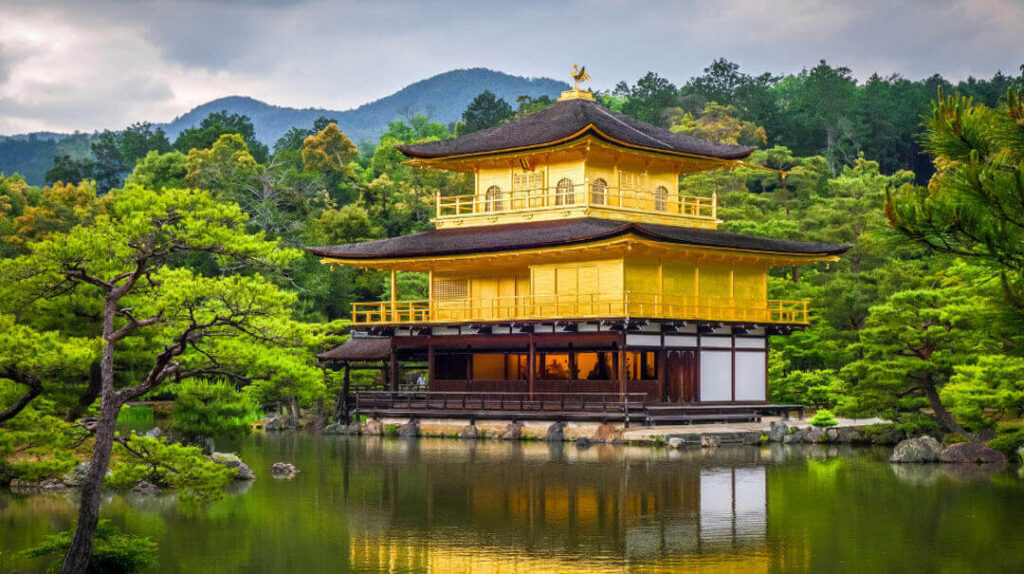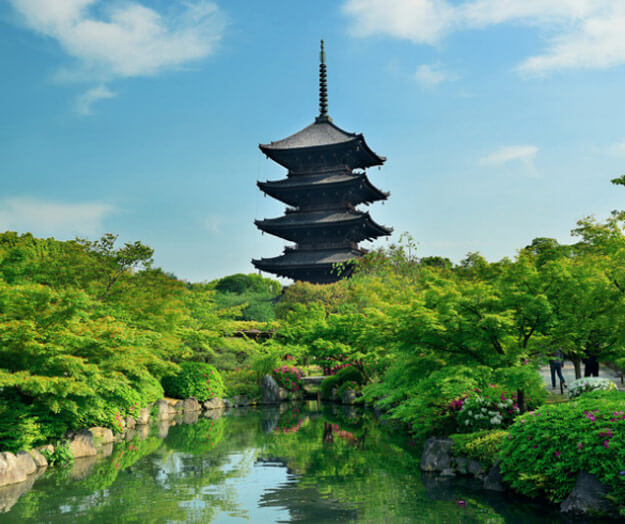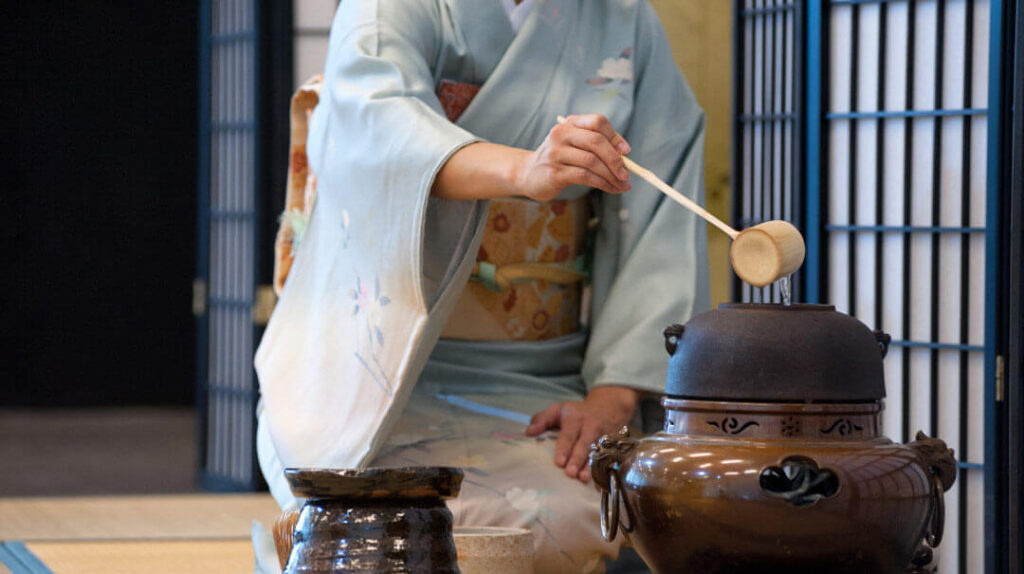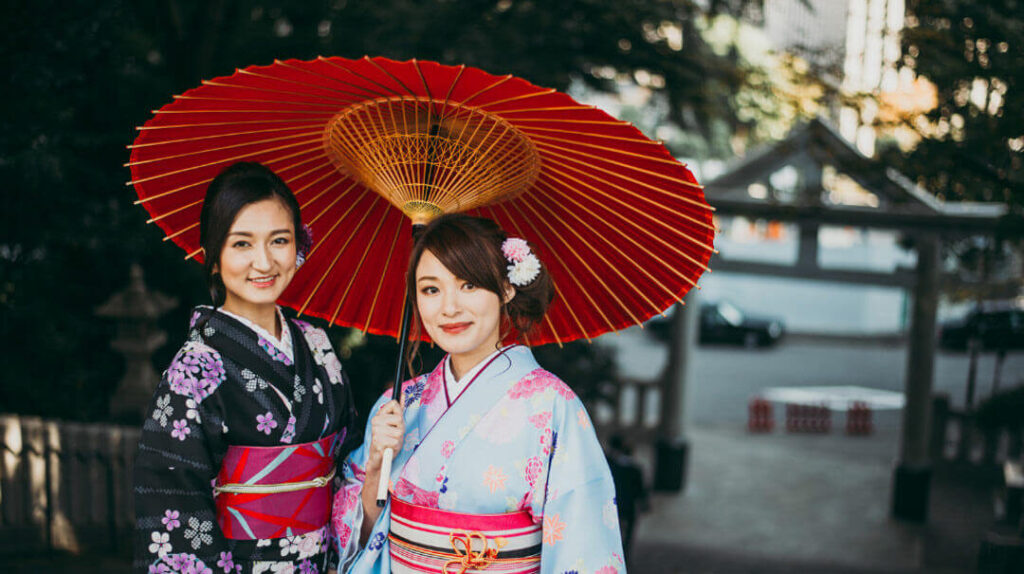Welcome to the AHG Kyoto travel guide. Situated in the heart of Japan’s Kansai region, Kyoto stands as a captivating bridge between Japan’s rich historical past and its vibrant present. Renowned as the country’s cultural and imperial capital for over a millennium, Kyoto’s illustrious history is woven into the very fabric of its existence. As you wander through its enchanting streets, you’ll find yourself immersed in a world where ancient temples, traditional tea ceremonies, and geisha culture coexist harmoniously with a modern cityscape. Kyoto is a destination that beckons travelers to embark on a journey through time, allowing them to witness the elegance of Japan’s past while embracing the innovation of its future.
Kyoto: A Journey into Timeless Japan
The name “Kyoto” itself carries echoes of antiquity, translating to “capital city” or “capital metropolis.” Founded in 794 as Heian-kyo (Capital of Peace and Tranquility), the city served as Japan’s imperial capital for more than a thousand years until the emperor moved the capital to Tokyo in 1868. Despite this transition, Kyoto retained its cultural significance and historical legacy.
Location and Geography: Situated in the central part of Honshu, Japan’s main island, Kyoto enjoys a strategic location surrounded by picturesque mountains on three sides. The Kamo River gracefully winds its way through the city, adding to the natural beauty of the landscape. This topography not only contributes to Kyoto’s scenic charm but also influences its distinct seasons.
The People of Kyoto: Kyoto’s residents, known as “Kyotoites,” take immense pride in their city’s heritage and traditions. While embracing modernity, they are dedicated to preserving the cultural treasures passed down through generations. As you interact with Kyotoites, you’ll find them to be warm, welcoming, and eager to share their customs and stories.
Recent History: In the 20th century, Kyoto faced the challenges of urbanization and industrialization, just like many other Japanese cities. However, it successfully balanced modernization with cultural preservation. During World War II, Kyoto was spared from the devastating bombings that affected other major cities, thanks to its historical significance. This spared the city’s architectural treasures from destruction, allowing Kyoto to maintain its timeless ambiance.
A Glimpse of Kyoto as an Asia Holiday Destination: Kyoto embodies the essence of Japan’s cultural identity and serves as a gateway to understanding the nation’s history, customs, and aesthetic values. As an Asia holiday destination, Kyoto offers travelers a unique opportunity to:
- Immerse themselves in the elegance of traditional tea ceremonies.
- Explore stunning Shinto shrines and serene Buddhist temples.
- Witness the captivating beauty of cherry blossoms in spring and fiery foliage in autumn.
- Savor Kyoto’s renowned kaiseki cuisine, an artful form of dining.
- Encounter geisha and maiko (apprentice geisha) in the city’s historic Gion district.
- Stroll through meticulously preserved neighborhoods like Higashiyama, where the atmosphere transports you to centuries past.
Whether you’re a history enthusiast, a nature lover, or a gastronomic adventurer, Kyoto’s multifaceted allure promises a remarkable journey. It invites you to step off the beaten path and embark on a cultural odyssey that transcends time itself.
Kyoto, with its balance of tradition and innovation, stands as an embodiment of Japan’s capacity to evolve while honoring its heritage. It invites travelers to explore the intricate tapestry of its past, which remains vibrantly interwoven with its present, making it a destination that captures the essence of timeless Japan. As you embark on your journey through Kyoto, you’ll find yourself not merely visiting a place but rather, experiencing a living testament to the beauty of continuity in a rapidly changing world.

Tokyo Japan

Must-Visit Attractions
Must-Visit Attractions and Landmarks in Kyoto
Kyoto is a city rich in cultural heritage, offering travelers a glimpse into Japan’s glorious past. Here are some must-visit attractions and landmarks in Kyoto:
Kinkaku-ji (The Golden Pavilion):
- A stunning Zen Buddhist temple covered in gold leaf.
- Explore the beautifully landscaped gardens surrounding the pavilion.
- Witness the shimmering reflection of Kinkaku-ji in the adjacent Mirror Pond.
Fushimi Inari Taisha:
- Home to thousands of vibrant red torii gates, creating mesmerizing pathways.
- Hike through the forested trails to reach the mountaintop for panoramic views.
- Discover hidden shrines and fox statues, messengers of the Shinto god Inari.
Kiyomizu-dera:
- A UNESCO World Heritage Site and a marvel of wooden architecture.
- Enjoy panoramic views of Kyoto from its wooden terrace.
- Visit the Otawa Waterfall and drink from its three streams, symbolizing health, longevity, and success in studies.
Gion District:
- Kyoto’s famous geisha district, known for preserving traditional Japanese culture.
- Stroll through atmospheric streets lined with wooden machiya houses.
- Spot geisha and maiko on their way to appointments.
Arashiyama Bamboo Grove:
- Walk through towering bamboo groves in the scenic Arashiyama district.
- Visit the picturesque Togetsukyo Bridge and the Tenryu-ji Temple.
Nijo Castle:
- An architectural masterpiece known for its “nightingale floors” that chirp when walked upon.
- Explore beautiful gardens and historical buildings within the castle complex.
Philosopher’s Path:
- A tranquil walk along the canal lined with hundreds of cherry blossoms.
- Ideal for a leisurely stroll during the cherry blossom season in spring.
Ginkaku-ji (The Silver Pavilion):
- A Zen temple famous for its silver-colored exterior.
- Explore the meticulously designed sand and stone gardens.
Kyoto Imperial Palace:
- Discover the elegant buildings and beautiful gardens of the former imperial residence.
- Guided tours offer insights into Japan’s imperial history.
Nanzen-ji Temple:
- A serene Zen temple featuring a massive wooden gate and beautiful aqueduct.
- Climb to the top of the Sanmon gate for panoramic views of Kyoto.
Tofuku-ji Temple:
- Known for its spectacular autumn foliage, particularly the Tsutenkyo Bridge.
- Explore the Zen gardens and serene temple grounds.
Kyoto Tower:
- Offers panoramic views of the city from its observation deck.
- Particularly stunning at night when the city lights up.
These attractions showcase Kyoto’s rich history, stunning natural beauty, and cultural depth, making it a city that beautifully blends tradition and modernity.
How to Get To Kyoto
Kyoto’s central location in Japan and excellent transportation infrastructure make it easily accessible for travelers. Here’s how to get to Kyoto:
By Air:
- The nearest major airport is Kansai International Airport (KIX), located about 100 kilometers (62 miles) from Kyoto.
- Osaka International Airport (Itami Airport) is also an option, about 50 kilometers (31 miles) away.
- From either airport, you can take a direct bus, train, or taxi to Kyoto.
By Train:
- Shinkansen (Bullet Train): Kyoto is well-connected to major Japanese cities via the Shinkansen network. Travel times are approximately:
- Tokyo to Kyoto: About 2.5 to 3 hours.
- Osaka to Kyoto: About 15 to 30 minutes.
- Hiroshima to Kyoto: About 1.5 to 2 hours.
- Kyoto Station is a major transportation hub with convenient access to the city center.
- Shinkansen (Bullet Train): Kyoto is well-connected to major Japanese cities via the Shinkansen network. Travel times are approximately:
By Bus:
- Long-distance buses operate between Kyoto and various cities in Japan.
- Overnight buses offer a budget-friendly travel option.
By Car:
- Renting a car is not recommended for exploring Kyoto itself, as many areas have limited parking, and public transportation is efficient. However, it can be convenient for exploring nearby regions.
By Bicycle:
- Kyoto is a bike-friendly city with rental shops and dedicated bike lanes.
- Cycling is a fantastic way to explore the city at a relaxed pace.
Once you arrive in Kyoto, the city’s comprehensive public transportation system, including buses and subways, makes it easy to navigate and explore its many attractions.
Best Time To Go Kyoto
The best time to visit Kyoto depends on your preferences for weather and experiences. Here’s a breakdown of the seasons and what they offer:
Spring (March to May):
- Cherry Blossom Season: Late March to early April is the prime time for cherry blossoms (sakura). Kyoto’s parks and temples burst into a sea of pink and white blossoms.
- Pleasant weather with mild temperatures.
Summer (June to August):
- Warm and humid weather with occasional rain showers.
- Kyoto hosts traditional festivals like Gion Matsuri in July.
- Explore lush gardens and enjoy summer kaiseki cuisine.
Autumn (September to November):
- Stunning autumn foliage (koyo) from late October to early December.
- Pleasant weather with cool temperatures.
- Ideal for hiking and temple visits.
Winter (December to February):
- Fewer tourists, making it easier to explore popular sites.
- Winter illuminations and events add a festive atmosphere.
- Cool to cold temperatures, so dress warmly.
Each season offers a unique Kyoto experience, from cherry blossoms in spring to colorful foliage in autumn. Consider your preferences for weather and events when planning your visit.
Best Way To Get Around
Getting around Kyoto is convenient, thanks to its well-organized public transportation system. Here are the best ways to navigate the city:
Bus:
- Kyoto’s extensive bus network covers most tourist destinations.
- Purchase a Kyoto City Bus One-Day Pass for unlimited bus rides.
- Buses are easy to use, with route maps available in English.
Subway:
- Kyoto has two subway lines, the Karasuma Line and the Tozai Line.
- Subways are efficient for traveling between some major attractions.
Trains:
- The JR Kyoto Station is a central hub for train travel, including Shinkansen (bullet trains).
- Trains are excellent for day trips to nearby cities like Osaka and Nara.
Bicycle:
- Rent a bicycle to explore Kyoto at a relaxed pace.
- Many areas have dedicated bike lanes and bike rental shops.
Walking:
- Kyoto’s compact city center is easily navigable on foot.
- Walking allows you to discover hidden gems and take in the city’s charm.
Taxi:
- Taxis are readily available but can be expensive compared to public transportation.
- Taxis are convenient for reaching specific destinations not well-served by buses or subways.
Rideshare:
- Uber operates in Kyoto, providing an alternative to traditional taxis.
Rickshaws:
- Consider taking a traditional rickshaw ride for a unique and eco-friendly transportation experience.
Navigating Kyoto is straightforward, with clear signage and English-language information at major tourist sites. Depending on your itinerary and preferences, you can mix and match these transportation options for a seamless travel experience.

Off the Beaten Path Hidden Gems
While Kyoto’s iconic attractions are a must-visit, exploring its hidden gems offers a deeper connection to the city’s culture and history. Here are some off-the-beaten-path experiences in Kyoto:
Kurama and Kibune:
- A serene mountain village known for its onsen (hot springs).
- Hike from Kurama to Kibune, enjoying lush forests and riverside dining.
- Experience a traditional ryokan stay with a private onsen bath.
Ohara:
- A tranquil village famous for its Sanzen-in Temple.
- Explore lush gardens, moss-covered statues, and pristine temples.
- Discover local artisans, including indigo dyeing workshops.
Flea Markets and Antique Shopping:
- Visit monthly flea markets like To-ji Temple Flea Market and Kitano Tenmangu Shrine Flea Market.
- Find unique antiques, ceramics, kimono, and vintage treasures.
Rozan-ji Temple:
- A hidden gem with a beautiful stone garden.
- Enjoy serene moments away from the crowds.
Honen-in Temple:
- A serene temple known for its peaceful atmosphere and stunning moss garden.
- Ideal for meditation and reflection.
Kokedera (Moss Temple):
- Accessible by reservation only, this temple features lush moss gardens and unique calligraphy.
- An exclusive and tranquil experience.
Sagano Scenic Railway:
- A charming sightseeing train along the Hozugawa River.
- Offers picturesque views of Kyoto’s countryside.
Adashino Nenbutsu-ji Temple:
- A tranquil temple with thousands of stone statues.
- An eerie and captivating place to explore.
These hidden gems offer a quieter, more intimate Kyoto experience, allowing you to connect with the city’s natural beauty and cultural depth away from the crowds.

Nara Japan
Local Cuisine / Best Restaurants?
Kyoto is renowned for its traditional cuisine, known as kyo-ryori, which reflects the city’s rich cultural heritage. Here are some must-try dishes and the best restaurants to savor them:
Kaiseki Ryori:
- Kyoto’s multi-course haute cuisine, emphasizing seasonality and aesthetics.
- Try it at Michelin-starred restaurants like Kikunoi or Hyotei.
Yudofu (Tofu Hot Pot):
- A delicate tofu dish simmered in a savory broth.
- Enjoy it at Tousuiro, a famous tofu restaurant.
Sushi:
- Kyoto offers exceptional sushi with an emphasis on fresh, local ingredients.
- Try Sushi Masuda for an unforgettable experience.
Matcha and Wagashi:
- Kyoto is famous for matcha (green tea) and wagashi (traditional sweets).
- Visit Gion Tsujiri for matcha treats and Toraya for wagashi.
Obanzai:
- Kyoto’s home-style cooking, featuring seasonal vegetables and ingredients.
- Head to Kawa Cafe for a taste of obanzai.
Kyo Kaiseki:
- A more casual version of kaiseki cuisine, emphasizing local flavors.
- Try Gion Nanba for kyo kaiseki dishes.
Okonomiyaki:
- Savory Japanese pancakes filled with various ingredients.
- Sample delicious okonomiyaki at Mizuno.
Takoyaki:
- Osaka’s famous street food is also popular in Kyoto.
- Visit Kyoto Takoyaki Katsu for crispy takoyaki balls.
Soba and Udon:
- Enjoy handmade soba (buckwheat noodles) or udon (wheat noodles).
- Try Okudohan for soba or Udon Mugimaru for udon.
Yuba (Tofu Skin):
- Kyoto is famous for yuba, the skin formed during tofu production.
- Savor yuba dishes at Kyoto Yuba Kamogawa.
These culinary delights are just a glimpse of Kyoto’s gastronomic offerings. Exploring the city’s dining scene is an integral part of your Kyoto experience.

Activities in Kyoto
Kyoto offers a wealth of activities for travelers seeking to immerse themselves in its culture and history. Here are some engaging activities to consider:
Tea Ceremony:
- Participate in a traditional Japanese tea ceremony to learn about matcha preparation and its cultural significance.
- Try En Tea Ceremony Experience for an authentic experience.
Kimono Rental and Stroll:
- Rent a kimono and explore Kyoto’s historic neighborhoods, such as Gion or Arashiyama.
- Companies like Yumeyakata offer kimono rental services.
Japanese Calligraphy (Shodo):
- Join a calligraphy class to practice writing beautiful characters with brush and ink.
- Enroll in a session at Shodo Kawakami.
Ikebana (Flower Arranging):
- Discover the art of ikebana and create your floral arrangement under the guidance of a master.
- Experience it at Koryu Center.
Pottery Classes:
- Kyoto is known for its pottery, and you can try your hand at creating your own ceramics.
- Take a pottery class at Kyoto Ceramic Center.
Traditional Crafts Workshops:
- Explore traditional crafts like weaving, dyeing, and fan-making.
- Visit Maikoya Kyoto for various workshop options.
Bamboo Craft Experience:
- Learn bamboo craft techniques, including basket weaving and flute making.
- Experience it at Kyoto Bamboo Craft Center.
Zen Meditation:
- Practice Zen meditation and mindfulness at a local temple.
- Join a meditation session at Shunkoin Temple.
Noh or Kabuki Theater:
- Attend a performance of classical Noh or colorful Kabuki theater to witness Japan’s dramatic arts.
- Check schedules at Minami-za Theater.
Bamboo Forest Walk:
- Explore lesser-known bamboo groves like the Chikurin no Michi in Sagano.
- Enjoy a peaceful stroll amid bamboo.
These activities allow you to engage with Kyoto’s cultural heritage and create meaningful memories during your visit.

Unique Cultural Experiences
Kyoto is a city where tradition and culture are deeply ingrained in everyday life. Embrace these unique cultural experiences to gain a deeper understanding of Kyoto’s heritage:
Maiko and Geisha Encounters:
- Arrange to meet a maiko (apprentice geisha) for a traditional tea ceremony or performance.
- Book an experience at Miyako Odori or Gion Hatanaka.
Traditional Theater Workshops:
- Participate in workshops on traditional Japanese theater arts like Noh, Kabuki, or Kyogen.
- These workshops provide hands-on experiences and insights into performance arts.
Zen Meditation Retreats:
- Immerse yourself in Zen Buddhism through meditation retreats at Zen temples.
- Retreats offer a chance to experience monastic life and learn meditation techniques.
Fushimi Inari Taisha Rituals:
- Witness or participate in Shinto rituals at Fushimi Inari Taisha, such as omikuji (fortune-telling) or ema (wooden votive plaques).
- Gain insight into Shinto practices and beliefs.
Buddhist Temple Stays:
- Stay overnight at a Buddhist temple to experience the monastic lifestyle.
- Participate in morning rituals and meditation sessions.
Kimono Photoshoots:
- Dress in a beautiful kimono and have a professional photoshoot in historic Kyoto settings.
- Capture stunning memories of your visit.
Traditional Tea House Visits:
- Explore historic tea houses like Camellia or Ueda Soko for a traditional tea experience.
- Enjoy matcha and sweets in an authentic setting.
Koto (Japanese Harp) Performance:
- Attend a koto performance to appreciate the soothing sounds of this traditional instrument.
- Some venues offer interactive sessions to try playing the koto.
Geisha and Maiko Dance Performances:
- Enjoy traditional dance performances by geisha and maiko in Kyoto’s geisha districts.
- Performances often include seasonal themes and exquisite costumes.
These unique cultural experiences offer insight into Kyoto’s traditions and provide an opportunity to engage with its rich heritage.
Language
While Japanese is the primary language spoken in Kyoto, English is often used in tourist areas and establishments. However, learning a few basic Japanese phrases can enhance your experience and interactions with locals. Here are some helpful phrases:
- Hello: こんにちは (Konnichiwa)
- Thank you: ありがとう (Arigatou)
- Yes: はい (Hai)
- No: いいえ (Iie)
- Excuse me / I’m sorry: すみません (Sumimasen)
- Please: お願いします (Onegaishimasu)
- How much is this?: これはいくらですか? (Kore wa ikura desu ka?)
- I don’t understand: わかりません (Wakarimasen)
- Do you speak English?: 英語を話せますか? (Eigo o hanasemasu ka?)
While many locals in Kyoto working in the tourism industry speak English, making an effort to use a few Japanese phrases is appreciated and can lead to more meaningful interactions.
Accommodation in Kyoto
Kyoto offers a diverse range of accommodation options to suit different preferences and budgets. Here are some types of accommodations you can find in the city:
Ryokan (Traditional Inns):
- Experience Japanese hospitality and traditions at ryokan.
- Sleep on futon beds, dine on kaiseki cuisine, and enjoy communal baths.
- Recommended ryokan: Tawaraya, Hiiragiya, Yoshikawa Inn.
Hotels:
- Kyoto has a wide selection of hotels ranging from luxury to budget-friendly.
- Some popular choices include Hotel Granvia Kyoto, The Ritz-Carlton Kyoto, and APA Hotel Kyoto Ekimae.
Machiya (Traditional Townhouses):
- Stay in beautifully restored machiya, traditional wooden townhouses.
- Enjoy the charm of historical Kyoto with modern amenities.
- Recommended machiya: Kyoto Machiya Bukko-ji, Machiya Residence Inn.
Guesthouses and Hostels:
- Budget travelers can find guesthouses and hostels offering dormitory and private rooms.
- Piece Hostel Kyoto, Len Kyoto Kawaramachi, and Kyoto Morris Hostel are popular options.
Capsule Hotels:
- Experience a unique stay in compact capsule hotels designed for solo travelers.
- 9h nine hours Kyoto and First Cabin Kyoto Arashiyama offer capsule accommodations.
Airbnb:
- Explore various Airbnb listings, including traditional houses and modern apartments.
- Look for properties in central neighborhoods like Gion, Higashiyama, or Arashiyama.
Temple Lodgings:
- Some temples in Kyoto offer lodging for visitors seeking a spiritual experience.
- Stay overnight at temples like Shunkoin Temple or Shojoshin-in Temple.
Minshuku (Japanese Bed and Breakfast):
- Enjoy a cozy, family-run accommodation experience with home-cooked meals.
- Okutan Kiyomizu is a well-regarded minshuku.
When choosing accommodation in Kyoto, consider your budget, preferred style of lodging, and proximity to the attractions you plan to visit.
Osaka Japan
How's the weather in Kyoto?
Kyoto experiences distinct seasons, each offering a different atmosphere and activities. Here’s an overview of Kyoto’s weather throughout the year:
Spring (March to May):
- Spring is one of the most popular times to visit Kyoto due to cherry blossom season.
- March is cool, while April and May are mild and pleasant.
Summer (June to August):
- Summers are hot and humid in Kyoto, with occasional rain showers.
- June is the rainy season (tsuyu), and July and August are the warmest months.
Autumn (September to November):
- Autumn brings comfortable temperatures and stunning fall foliage.
- September is pleasant, while October and November offer cool, crisp days.
Winter (December to February):
- Winters in Kyoto are cold but dry, with occasional snowfall.
- December and January are the coldest months, while February starts to warm up.
The best time to visit Kyoto depends on your preferences. Cherry blossom season (late March to early April) and autumn foliage (late October to early December) are the most picturesque times, but Kyoto’s beauty can be appreciated year-round.
Recommended Itinerary
1 Week in Kyoto
A week in Kyoto allows you to explore its iconic attractions, hidden gems, and cultural experiences. Here’s a suggested itinerary:
Day 1: Arrival in Kyoto
- Arrive in Kyoto and check into your accommodation.
- Explore Kyoto Station and its underground mall for shopping and dining options.
- Enjoy a welcome dinner at a local restaurant.
Day 2: Kyoto’s Historic Districts
- Start your day in Gion, Kyoto’s geisha district.
- Visit Kiyomizu-dera Temple for panoramic views.
- Explore Higashiyama’s historic streets, including Ninenzaka and Sannenzaka.
- Dinner at a traditional machiya restaurant in Gion.
Day 3: Arashiyama and Bamboo Grove
- Head to Arashiyama and visit the Bamboo Grove.
- Explore Tenryu-ji Temple and its beautiful gardens.
- Take a scenic boat ride on the Hozugawa River.
- Enjoy dinner in Arashiyama.
Day 4: Kyoto’s Imperial Treasures
- Explore Kyoto Imperial Palace and its gardens.
- Visit Sento Palace and its beautiful architecture.
- Stroll along Philosopher’s Path, lined with cherry blossoms or fall foliage.
- Evening visit to Eikando Temple.
Day 5: Nijo Castle and Kyoto’s Craftsmanship
- Begin your day at Nijo Castle, known for its “nightingale floors.”
- Visit Nishiki Market for culinary delights.
- Explore traditional crafts at Kyoto Handicraft Center.
- Experience a tea ceremony in the afternoon.
Day 6: Day Trip to Nara
- Take a day trip to Nara, known for its friendly deer and historic sites.
- Visit Todai-ji Temple and the Great Buddha.
- Explore Nara Park and Kasuga Taisha Shrine.
- Return to Kyoto for dinner.
Day 7: Kyoto’s Zen Moments
- Experience Zen meditation at a local temple.
- Visit the stunning Silver Pavilion, Ginkaku-ji.
- Explore the peaceful Philosopher’s Path.
- Evening stroll in the Gion district.
This itinerary provides a mix of Kyoto’s iconic landmarks, cultural experiences, and moments of tranquility. Customize it based on your interests and the time of year you visit Kyoto.
Conclusion
Kyoto, with its rich history, stunning landscapes, and deep-rooted traditions, offers travelers a captivating journey into Japan’s cultural heart. Whether you’re exploring iconic temples, savoring exquisite cuisine, or participating in unique cultural experiences, Kyoto promises a memorable adventure that will resonate long after your visit.

